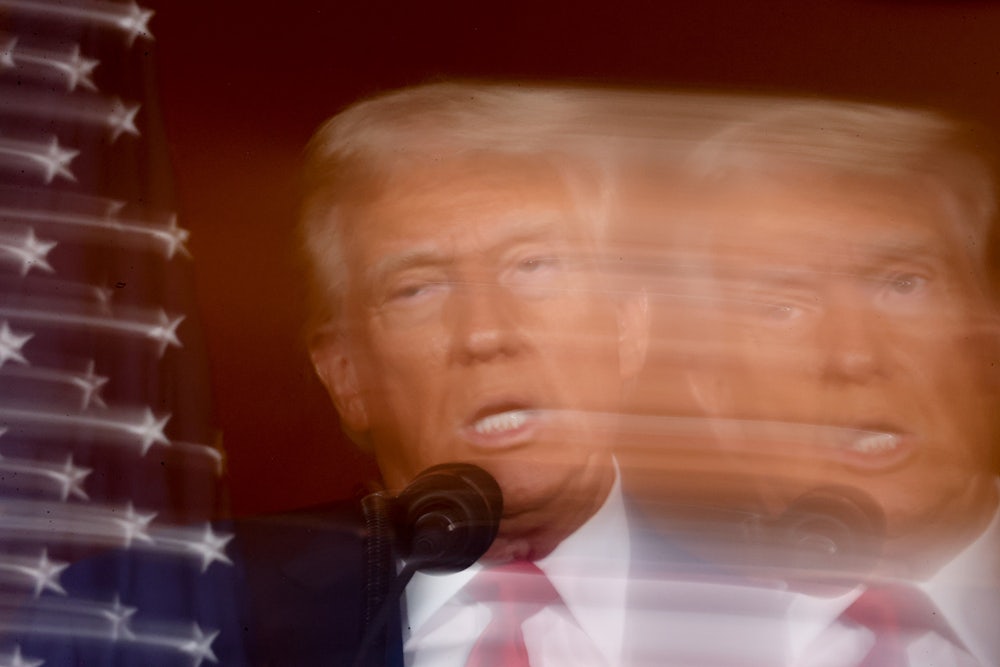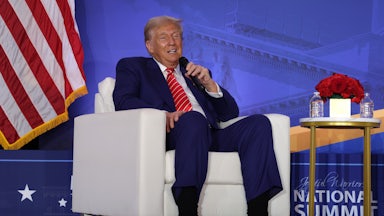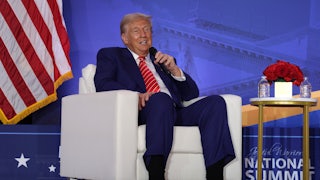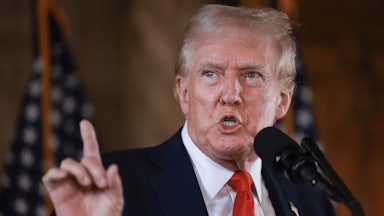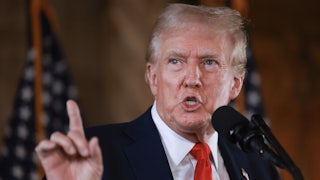Four years ago, in an article for Media Matters for America, I warned that journalists were sanitizing Donald Trump’s incoherent ramblings to make them more palatable for the average voter. The general practice went like this: The press would take something Trump said or did—for instance, using a visit to the Centers for Disease Control to ask about Fox News’s ratings, insult then–Washington Governor Jay Inslee, rant about his attempt to extort Ukraine into digging up dirt on Joe Biden, and downplay the rising number of Covid-19 cases in the U.S.—and write them up as The New York Times did: “Trump Says ‘People Have to Remain Calm’ Amid Coronavirus Outbreak.” This had the effect of making it seem like Trump’s words and actions seemed cogent and sensible for the vast majority of Americans who didn’t happen to watch his rant live.
Flash-forward to today, and it’s clear this problem has only worsened. As Trump’s statements grow increasingly unhinged in his old age, major news outlets continue to reframe his words, presenting a dangerously misleading picture to the public.
For instance, last week, Trump posted the following to his Truth Social account:
I have reached an agreement with the Radical Left Democrats for a Debate with Comrade Kamala Harris. It will be Broadcast Live on ABC FAKE NEWS, by far the nastiest and most unfair newscaster in the business, on Tuesday, September 10th, in Philadelphia, Pennsylvania. The Rules will be the same as the last CNN Debate, which seemed to work out well for everyone except, perhaps, Crooked Joe Biden. The Debate will be “stand up,” and Candidates cannot bring notes, or “cheat sheets.” We have also been given assurance by ABC that this will be a “fair and equitable” Debate, and that neither side will be given the questions in advance (No Donna Brazile!). Harris would not agree to the FoxNews Debate on September 4th, but that date will be held open in case she changes her mind or, Flip Flops, as she has done on every single one of her long held and cherished policy beliefs. A possible third Debate, which would go to NBC FAKE NEWS, has not been agreed to by the Radical Left. GOD BLESS AMERICA!
CNN described that rambling, insult-laden, conspiracy-riddled wall of text—itself a pretty good example of what he spends his time off the campaign trail doing—by writing, “Former President Donald Trump on Tuesday announced he has ‘reached an agreement’ to participate in a September 10 debate with Vice President Kamala Harris, noting that ‘the rules will be the same as the last CNN debate, which seemed to work out well for everyone.’”
Does that really capture what Trump posted?
Days earlier, Trump heralded the endorsement of Robert F. Kennedy Jr., a man who has long pushed baseless claims that vaccines cause autism, by saying that “a panel of top experts, working with Bobby,” would “investigate what is causing the decades-long increase in chronic health problems and childhood diseases, including autoimmune disorders, autism, obesity, infertility, and more.”
In its write-up of that portion of Trump’s speech, The New York Times omitted Trump’s mention of autism, simply writing that “Mr. Trump said that, if elected to a second term, a panel of experts ‘working with Bobby’ would investigate obesity rates and other chronic health issues in the United States.” By removing the mention of autism, which should be a red flag whenever paired with a mention of Kennedy, the Times took an obvious nod to a conspiracy theory and turned it into a normal-sounding policy proposal.
While speaking at an event put on by the extremist group Moms for Liberty, Trump spread a baseless conspiracy theory that “your kid goes to school and comes home a few days later with an operation,” referring to transition-related surgeries for trans people. In their write-up of the event, a glowing piece about how Trump “charmed” this group of “conservative moms,” the Times didn’t even mention the moment where he blathered on and on about a crazy conspiracy that has and will never happen.
This “sanewashing” of Trump’s statements isn’t just poor journalism; it’s a form of misinformation that poses a threat to democracy. By continually reframing Trump’s incoherent and often dangerous rhetoric as conventional political discourse, major news outlets are failing in their duty to inform the public and are instead providing cover for increasingly erratic behavior from a former—and potentially future—president.
The consequences of this journalistic malpractice extend far beyond misleading headlines. By laundering Trump’s words in this fashion, the media is actively participating in the erosion of our shared reality. When major news outlets consistently present a polished version of Trump’s statements, they create an alternate narrative that exists alongside the unfiltered truth available on social media and in unedited footage.
Voters who rely solely on traditional news sources are presented with a version of Trump that bears little resemblance to reality. They see a former president who, while controversial, appears to operate within the bounds of normal political discourse—or at worst, is breaking with it in some kind of refreshing manner. You can see this folie à deux at work in a recent Times piece occasioned by Trump’s amplification of social media posts alleging that Harris owed her career to the provision of “blowjobs”: “Though he has a history of making crass insults about his opponents, the reposts signal Mr. Trump’s willingness to continue to shatter longstanding norms of political speech.” Meanwhile, those who seek out primary sources encounter a starkly different figure—one prone to conspiracy theories, personal attacks, and extreme rhetoric.
The Atlantic’s Jeffrey Goldberg wrote about this in a June newsletter, explaining the role the press plays in this sanitation of Trump by journalists while remarking on a rambling speech in which Trump went on a tangent about shark attacks and using some sort of electrocution device to fend them off:
It works like this: Trump sounds nuts, but he can’t be nuts, because he’s the presumptive nominee for president of a major party, and no major party would nominate someone who is nuts. Therefore, it is our responsibility to sand down his rhetoric, to identify any kernel of meaning, to make light of his bizarro statements, to rationalize. Which is why, after the electric-shark speech, much of the coverage revolved around the high temperatures in Las Vegas, and other extraneities. The Associated Press headline on a story about the event read this way: “Trump Complains About His Teleprompters at a Scorching Las Vegas Rally.” The New York Times headlined its story thus: “In Las Vegas, Trump Appeals to Local Workers and Avoids Talk of Conviction.” CNN’s headline: “Trump Proposes Eliminating Taxes on Tips at Las Vegas Campaign Rally.”
Over the weekend, the Times seemed intent on validating Goldberg’s words with a questionable “campaign notebook” article titled “Meandering? Off-Script? Trump Insists His ‘Weave’ Is Oratorical Genius.”
Writer Shawn McCreesh drew generous parallels between Trump’s speaking style and celebrated wordsmiths:
Certainly, in the history of narrative, there have been writers celebrated for their ability to be discursive only to cleverly tie together all their themes with a neat bow at the end—William Shakespeare, Charles Dickens and Larry David come to mind.
He then added, “But in the case of Mr. Trump, it is difficult to find the hermeneutic methods with which to parse the linguistic flights that take him from electrocuted sharks to Hannibal Lecter’s cannibalism, windmills and Rosie O’Donnell.”
McCreesh didn’t stop there. He went on to liken Trump to literary giants James Joyce and William Faulkner, and even psychoanalyst Sigmund Freud.
“In a world of canned political speeches, Mr. Trump’s style is beloved by his supporters, who enjoy these frequent glimpses into his id.”
This analysis goes beyond mere sanitization; it ventures into the realm of the absurd. By framing Trump’s incoherent ramblings as some form of avant-garde oratory, the Times isn’t just failing to accurately report—it’s actively warping reality to its readers.
The consequences of this extend beyond misleading headlines or sanitized quotes. It’s creating a dangerous disconnect between reality and reported news, fostering an environment where extreme rhetoric becomes normalized and conspiracy theories gain unwarranted legitimacy.
This won’t remain just a Trump problem. As other politicians observe the media’s willingness to soften and reframe inflammatory statements, we risk further degradation of political discourse. The bar for what’s considered acceptable rhetoric continues to lower, while the public’s ability to discern fact from fiction erodes.
To combat this, we need a paradigm shift in political reporting. Instead of contorting themselves to find rationality in incoherence, journalists should simply present politicians’ words and actions plainly, complete with fact-checks. This might mean rethinking traditional notions of “objectivity” that often lead to false equivalencies and misrepresentation.
Readers, too, have a role to play. We must seek out primary sources, demand more comprehensive reporting, and support news outlets that prioritize accuracy over access or the appearance of “balance.”
As we approach another critical election, the quality of our discourse hangs in the balance. The health of our democracy depends on an electorate that’s truly informed, not just placated with sanitized versions of reality. It’s time for both the media and the public to recommit to the pursuit of truth, however uncomfortable that may be.
